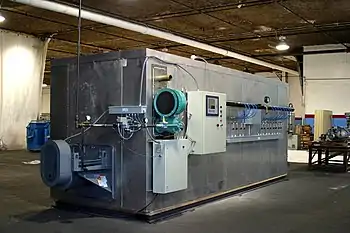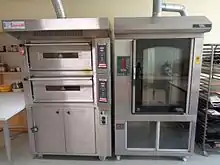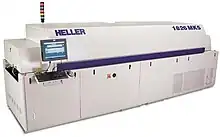Industrial oven
An Industrial oven is a heated chamber that is used for a variety of industrial applications including drying, curing, and baking components. These different types of ovens can be useful in different industries such as bakeries and industrial manufacturing. These ovens play a big factor in many industries and without these machines, work all together would be very difficult. Also, without these machines work in factories, bakeries, and curing manufacturers would be nearly impossible without the industrial oven invented by Jordan Mott in 1833. John created the first coal oven called a base burner and had a ventilation to burn the coal efficiently.[1]


Such ovens are used in many different applications, including chemical processing, food production, and even in the electronics industry, where circuit boards are run through a conveyor oven to attach surface mount components.[2]
Some common types of industrial ovens include:[3]
- Curing ovens – Designed to cause a chemical reaction in a substance once a specific temperature is reached. Powder coating is one common curing oven use.
- Drying ovens – Designed to remove moisture. Typical applications are pre-treating and painting. Such ovens are also sometimes known as kilns, though they do not reach the same high temperatures as are used in ceramic kilns.
- Baking ovens – Combines the function of curing and drying ovens.
- Reflow Ovens – A reflow oven is a machine used primarily for reflow soldering of surface mount electronic components to printed circuit boards (PCB). The oven contains multiple zones, which can be individually controlled for temperature. Generally, there are several heating zones followed by one or more cooling zones. The PCB moves through the oven on a conveyor belt, and is therefore subjected to a controlled time-temperature profile.
 A graphical example of a convection reflow oven.
A graphical example of a convection reflow oven. - Batch ovens – Also called cabinet or Walk-in/Truck-in ovens, batch ovens allow for curing, drying or baking in small batches using wheeled racks, carts or trucks. Ovens such as this are often found in large-volume bakeries in places such as supermarkets.
- Conveyor or Continuous Ovens – Typically part of an automated conveyor processing line, conveyor ovens allow for higher volume processing. Heat tunnels are an example.
- Clean room ovens – Designed for applications requiring a cleanroom, such as a semiconductor manufacturing or biotechnology processes.[4]
References
- "The Interesting Evolution of the Modern Oven". ThoughtCo. Retrieved 2023-05-11.
- "Preventative Maintenance for Industrial Ovens". www.pfonline.com.
- "Global Industrial Oven Market Analysis And Demand With Forecast Overview to 2027 Industry Synopsis and Key Players – Newsail, Guangzhou Kewei Microwave Energy, Sistem Teknik, Carbolite Gero". Sox Sphere.
- "High-Quality, Affordable Laboratory Oven Solutions". www.labmate-online.com.